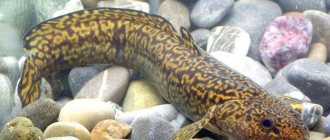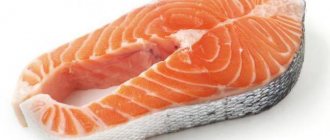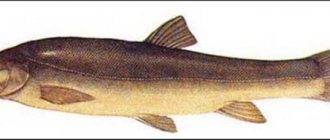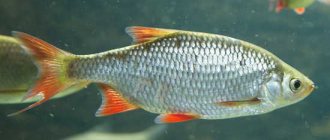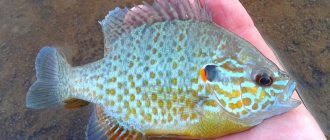Catfish fish: description
This is a huge fish, similar in appearance to eels or moray eels, but it is not even their closest relatives. The catfish represents the family of ray-finned fish and the order of perciformes. This fish is found in the waters of the northern hemisphere.
Appearance
It is not for nothing that this species of the family of ray-finned fish was given such a name, since the first thing that catches your eye when you meet it is the large upper fangs, which are noticeable even from the outside of the mouth. Catfish jaws are designed to hold potential prey in a death grip. At the same time, the chewing muscles are quite developed. Adults are so strong that they can easily bite through a fishing hook or the handle of a shovel. Typically, catfish snap shells and shells with their jaws like nuts. In such conditions, the catfish has to replace its teeth once a year. As a rule, this happens in winter, and instead of fallen teeth, new ones grow, which in just a month and a half will be able to fully perform their functions.
This fish has a highly elongated body, which bends when it moves, like the body of a snake. Such maneuverability became possible after catfish lost their pelvic fins. It is believed that the distant ancestors of catfish still had pelvic fins, as evidenced by the body structure of this fish. All catfish species known today have unpaired dorsal and anal fins, as well as huge fan-shaped pectoral fins. The caudal fin is not very developed, which is typical for fish moving slowly in the water column, and is not large in size. Some individuals can grow up to 2 and a half meters in length and weigh about 50 kg.
Behavior and lifestyle

A certain Canadian McDaniel was very frightened when he met a catfish at a depth of 20 meters, and this is not surprising, since its skull is wrinkled, like a rotten fruit, and is gray in color. The entire face of the catfish is so distorted that it resembles a continuous ulcer, while it has huge, swollen lips that occupy almost the entire width of the muzzle. Behind her lips, in her mouth grow large and powerful fangs that almost protrude outward. It seems that the catfish will open its huge mouth and swallow a person in an instant.
All catfish prefer to lead a bottom-dwelling lifestyle. Therefore, here at the bottom they feed, without much food. During the daytime, catfish stay in their shelters, which are caves, and at nightfall they go hunting. With the onset of cold weather (winter), catfish descend to depths where the temperature regime is more stable.
Interesting fact! Depending on the depths at which the catfish live, the development of the fish is directly proportional. The deeper the catfish live, the slower the growth.
Spotted catfish stick to more upper layers of water in summer compared to winter, but compared to striped catfish, they migrate over significantly longer distances. The common catfish prefers to be among rock crevices, as well as among algae, while it is perfectly camouflaged not only due to its coloring, but also due to the slow movements of its body. With the arrival of winter, when the catfish goes deeper, its camouflage color fades and becomes lighter.
The striped catfish, or sea wolf, as it is also called, quite often uses its fangs to protect itself from both natural enemies and its relatives. Experienced fishermen, if caught, handle catfish very carefully, as they can seriously injure a person.
How long do catfish live?
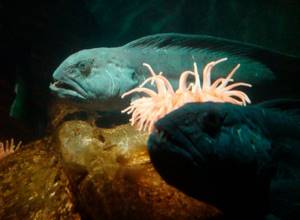
According to experts, if a catfish manages to avoid getting caught in fishing nets, it can live for about 2 decades.
Interesting fact! The catfish is considered a passive predator because it does not pursue its prey, but attacks it from cover. Therefore, to catch this fish using a spinning rod, you will have to try hard. To do this, it is necessary to unbalance the fish by irritating it. As a rule, catfish are teased by tapping a sinker on a hard surface (on rocks). The fishing method is called “knock fishing.”
Sexual dimorphism
Males are somewhat larger in size and also have a darker body color. In females, the muzzle is more attractive, since there is no swelling around the eyes and their lips are not so massive, and their chin is weakly defined.
CATCH
Features of character and lifestyle

Photo: Catfish fish
Catfish lead a predominantly sedentary lifestyle. Living at great depths, they rarely rise to the surface of the water. They have absolutely no need for this: at the bottom there is a huge number of inhabitants necessary for the normal diet of catfish. During the daytime, catfish usually “sit out” in shelters. I use caves as houses, where fish can easily hide and algae thickets.
The active life of catfish begins at nightfall. After sunset, hungry fish go hunting. During the night they completely replenish their supplies and, already full, go back to the shelter. The depth of habitat depends on the type of fish. Thus, spotted catfish hunt in the upper layers of the reservoir in summer. And ordinary catfish representatives are almost always found in gorges or large accumulations of algae. Regardless of the species, all catfish go to great depths in winter. This happens because the temperature at the bottom is much more stable and more comfortable for marine life.
Interesting fact: The rate at which a catfish’s body increases directly depends on the depth of its habitat. The higher the fish is, the faster it grows.
For humans, catfish inhabitants of the seas do not pose a particular threat. The main thing is not to touch them... Catfish are not active predators. It would never even occur to them to attack a person passing by. In addition, during daylight hours they most often hide in secluded places. However, fish can still bite a person who disturbs their peace. Anglers who have managed to catch catfish are warning of the potential threat from their jaws.
In addition, those who unexpectedly encounter this fish in person may experience serious disgust. It is definitely impossible to classify catfish as cute marine representatives. Their head is wrinkled, resembling an old untreated ulcer. The large size and dark color evoke fear and make you instantly remember all the horror films you have ever watched. Individual sensations are caused by teeth that can crush mollusk shells in seconds...
The lifespan of such fish is quite long. If the catfish is not caught in a net, it can live freely for up to 20-25 years. They do not form flocks. In natural conditions, catfish live alone. This allows them to move freely across the sea without thinking about other members of the group.
Types of catfish with photos
In nature, there are 5 species of catfish, with 3 species, such as common catfish, spotted catfish and blue catfish, inhabiting the waters of the North Atlantic, and the remaining 2 species, such as Far Eastern catfish and eel catfish, are found in the northern waters of the Pacific Ocean.
Common catfish
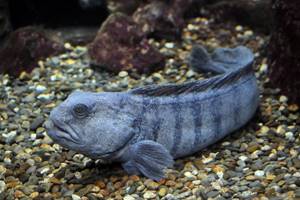
This type of catfish differs from other species by the presence of developed tuberculate teeth. The teeth of the lower jaw are slightly moved back, which makes it possible to effectively crush hard objects, along with the upper jaw. In addition, common or striped catfish are slightly smaller in size compared to spotted and blue catfish. Therefore, they do not grow longer than 1 meter 25 cm, while gaining weight a little more than 20 kg.
Spotted catfish
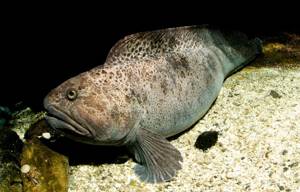
The spotted catfish is intermediate in characteristics between the striped and blue catfish. The spotted catfish is larger in size than the striped catfish, but is slightly smaller than the blue catfish. At the same time, it can reach a length of about one and a half meters and gains weight within 30 kg. This species has less developed teeth, which are distinguished by a tuberculate shape. Juveniles are painted in wide, black, transverse stripes, from which separate spots are then formed when the fish begins to lead a bottom-dwelling lifestyle.
Blue catfish
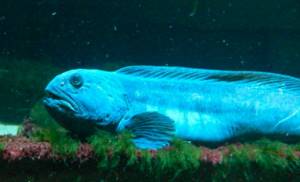
This species has the least developed tuberculate teeth, while the vomer row is shorter compared to the palatine rows. Adults grow to more than half a meter and gain weight of more than 30 kg.
It is known that there are individuals reaching a length of at least 2 meters. The color of the blue catfish is more monotonous, closer to darker tones and with barely noticeable spots that do not form obvious stripes.
Far Eastern catfish
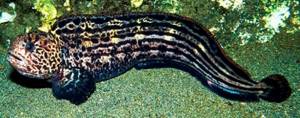
This species grows up to 1 meter in length, and maybe a little more. It differs from other species of Atlantic catfish in a slightly larger number of vertebrae, as well as rays in the anal fin. Moreover, this species has fairly strong tuberculate teeth, which allows adult individuals to easily crush fairly durable shells. Juvenile Far Eastern catfish are colored with dark stripes, which are located along, but not across the body. As the fish grows, the stripes begin to break apart into separate spots. After some time, in adult individuals these spots become more and more invisible, and then completely disappear against a dark background.
Eel catfish
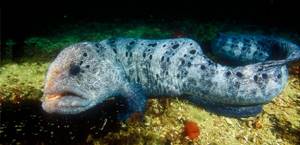
This particular type of catfish is classified as a separate species because they differ significantly from other species. The shape of the head and the structure of the teeth are almost the same as those of the Far Eastern catfish. At the same time, the body of the eel-shaped catfish is much longer, especially since it has more than 200 vertebrae, as well as a large number of rays in the dorsal and anal fins.
Adults often grow up to 2 and a half meters in length. Young individuals are distinguished by a unique coloring, consisting of longitudinal stripes, which, as they grow older, turn into spots that retain their color for almost their entire life.
Chemical composition and calorie content
Fish meat and caviar are saturated with omega-3 and omega-6 fatty acids and amino acids, vitamins B, C, E, PP, A, D. The product contains the following micro and macroelements:
- calcium;
- magnesium;
- iron;
- zinc;
- potassium;
- iodine;
- copper;
- sodium;
- manganese;
- phosphorus;
- chlorine;
- fluorine;
- sulfur;
- chromium;
- cobalt;
- nickel;
- molybdenum.
Calorie content of 100 g of raw fillet is 108–126 kcal. Speckled catfish has the fewest calories. Fats in the product are 5.2–5.8%, proteins are 16–20%, carbohydrates are 0%.

Table of the energy value of fish for various cooking methods:
| Processing method | Kcal per 100 g |
| Cooking | 114 |
| For a couple | 115 |
| Baking | 137 |
| Frying with oil | 195–214 |
| Grilled | 178 |
| Salting | 125 |
| Hot smoking | 130–138 |
| Cold smoking | 117 |
| Drying | 114–130 |

This is how catfish is dried
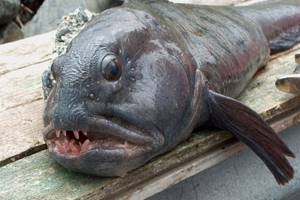
Range, habitats

Catfish are marine fish that prefer to live in temperate and cold waters of northern latitudes. They inhabit the continental shelf, adhering to impressive depths and the bottom of the reservoir. The habitat of the striped catfish is widespread:
- To the western waters of the Baltic and part of the Arctic Ocean.
- To the Faroe and Shetland Islands.
- To the northern parts of the Kola Peninsula.
- On the coastal waters of Norway, Iceland and Greenland.
- To the Motovsky and Kola bays.
- To Bear Island.
- On the western coast of Spitsbergen.
- On the Atlantic coast of North America.
Striped catfish are also found in the Barents and White Seas, mainly near coastlines of considerable depth.
Interesting to know! Spotted catfish are found in the same conditions as common catfish, and much more often in northern waters than in southern ones. Off the coast of Iceland, the number of striped catfish is approximately 20 times greater than that of spotted ones.
Spotted catfish chooses water areas located on the mainland shallows, but it is difficult to find it near the coast and in algae. She prefers to rest at an impressive depth of up to half a kilometer. Blue catfish are found in the same conditions as spotted catfish. Unlike other species, it is more mobile and prefers to be at depths of up to 1 km.
Far Eastern catfish are found in Norton Sound, within the Aleutian and Commander Islands, and Pribilof Island. In addition, it is found within the island of Hokkaido, as well as the eastern coasts of Kamchatka. The eel-like catfish prefers to live in water areas located within the Pacific coast of North America, ranging from California to Alaska (Kodiak Island).
How to choose fish
Product selection is one of the most important stages in cooking. Far Eastern catfish, like its other species, must be fresh.
Only a fresh product will have a beneficial effect on the human body.
When choosing a product, you should pay attention to the eyes of the fish. Dull eyes indicate that the product has been sitting on the counter for a long time. In this case, it is recommended to refuse the purchase.
Many people are convinced that they should not take frozen or fried fish, but this is also not entirely true. You should only purchase products that are not covered with a thick crust of ice. In this case, you can be sure of its benefits, this means that the fish has not been defrosted several times.
Catfish diet
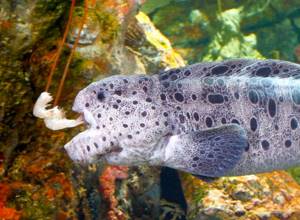
Divers identify the location of catfish by the “mountains” of empty shells and shells located at the entrances of the cave. The structure of catfish teeth is designed so that they can easily grind food items enclosed in shells or chitin.
The diet of catfish includes:
- Various crustaceans, including lobsters.
- Shellfish.
- Sea urchins.
- Sea stars.
- Snails.
- Jellyfish.
- Fish.
It is important to know! With the help of its powerful fangs, the catfish tears food objects from various surfaces, and with the help of its teeth it crushes them. When the process of changing teeth occurs, catfish either starve or swallow small food items whole if they are not covered with a shell.
Different types of catfish differ in that their gastronomic preferences differ, although not significantly. Striped catfish, for example, although it feeds on fish, eats little and prefers shellfish. Clams are also the best hook bait for catching striped catfish. The spotted catfish has a greater preference for echinoderms, although the rest of the diet is similar.
The Far Eastern catfish is characterized by the fact that it lives in coastal thickets and feeds on echinoderms, mollusks, fish and crustaceans. Blue catfish prefer jellyfish, ctenophores and fish. Other food items, especially shellfish, are present in its diet, but quite rarely. Because of this, blue catfish teeth do not wear out as much as other species, although they also change annually.
Harm and contraindications
Despite its great benefits, catfish can cause harm to health. The reason for this is an allergic reaction. If you are intolerant to seafood, the risk of becoming allergic to sea wolf increases.
Eating catfish meat is also contraindicated:
- Nursing mothers, pregnant women, and children under six years of age.
- For problems with the pancreas, gastritis, as well as for disorders of the endocrine glands.
- When following a diet that requires a small amount of protein food.
To get the benefits of catfish, you should not eat fish in excessive quantities. This dish should be included in the diet no more than two to three times a week.
Reproduction and offspring
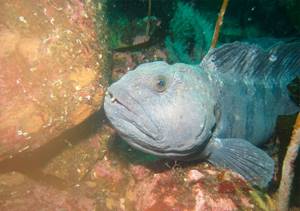
The fight for females in these species occurs once in a lifetime, after which the male remains faithful to his female throughout his life. Males arrange fights and butt heads in the literal sense of the word, while they use their formidable weapons - fangs and teeth. Thanks to fairly thick lips and massive thickenings in the eye area, opponents manage to avoid quite serious injuries. At the same time, there are always a lot of scars, and they remain for life.
Each species of catfish spawns differently. Striped catfish, depending on age, can lay from 600 to 40 thousand eggs, up to 6 mm in diameter. The eggs stick together into a ball and stick to hard surfaces. Males remain near the clutches for some time and protect their future offspring. The eggs develop quite slowly and fry, up to 2 cm in size, appear only in the spring, while the female lays eggs in the winter.
After birth, catfish fry rise closer to the surface, but having reached a size of approximately 7 cm, they return to the bottom again. After this, hardly anyone will see them in the water column.
Important fact! At the initial stages of their development, juveniles feed on zooplankton, but as they grow older they switch to a classic diet.
Spotted catfish, growing up to 1 meter in length and a little more, lay a maximum of 50 thousand eggs, the diameter of which is almost the same as that of other species. The masonry is also formed into balls, but their immersion depth is at least a hundred meters, and also at a considerable distance from the shore. After birth, the fry also first rise to the surface and remain in such conditions much longer than the fry of the striped catfish. After this they sink to the bottom.
The blue catfish, which is slightly larger than the spotted catfish, produces almost 30 thousand eggs of the same size as other species. Moreover, they spawn in spring, autumn or summer. Unfortunately, no one has found clutches of eggs of this species. As a rule, only unfertilized individuals are caught in the nets in the Barents Sea, which is why blue catfish are nicknamed widows. After birth, blue catfish fry remain in the upper layers of water for a long time before sinking to the bottom.
Far Eastern catfish lay eggs in the summer, and after hatching, the fry also rush to the surface layers of the water. Not a large number of fry survive from each clutch, much less survive to sexual maturity.
Beneficial features
The beneficial properties of catfish lie primarily in the presence in the fish meat of a huge amount of vitamins and mineral components that are required for the normal functioning of the human body.
What are the benefits of eating fish:
- Prevents the development of atherosclerosis, normalizing cardiac activity.
- Returns salt balance to normal and also rids tissues of excess fluid. This prevents swelling and the formation of salts in the joints and spine.
- Increases immunity.
- Reducing cholesterol levels. Fatty acids contained in fish, penetrating into the body, prevent the risk of developing cholesterol plaques, improving cardiac and vascular activity, as well as normalizing brain function.
In addition, it is recommended to eat catfish meat if you have obesity, cholecystitis, pancreatitis, diabetes and hypertension. However, in case of severe pain and during the period of exacerbation of the disease, it is advisable to refrain from eating fish. It will be possible to return the product to the diet only during the remission period.
It is worth clarifying that catfish will also be useful for those who play sports. Fish helps restore strength after heavy physical exertion, as well as normalize metabolism.
Nutritional value and calorie content
The meat of this fish is considered dietary, even though it contains a fairly large amount of proteins and fats.
Nutritional value (BJU-balance) per 100 g of product:
- proteins – 20 g;
- fats – 5.8 g;
- carbohydrates – 8 g.
The energy value of the product directly depends on exactly how the catfish was prepared.
On average, 100 grams of raw product contains 126 kilocalories. Boiled and steamed meat contains about 114 kcal, baked in the oven - 137 kcal, fried - 209 kcal, smoked - 130-134 kcal (depending on the cooking method).
The chemical composition of catfish fillet includes:
- amino acids;
- vitamins (A, B, C, D, E, PP);
- copper, molybdenum, cobalt, zinc, chromium and iron;
- mineral elements;
- unsaturated fatty acids.
All nutritional elements and nutrients found in fish are very easily and quickly digested. However, they do not disappear even after heat treatment of the product.
Fried catfish will also be healthy, but it is best to fry it not in a frying pan, but on the grill.

When losing weight
Those who adhere to a diet and PN are concerned about the question of whether catfish is fatty or not. As mentioned above, the calorie content of the fresh product is not very high, so this fish can be included in the diet menu.
The amount of fat and calories will vary depending on how the fish was prepared. To lose weight, it is advisable to bake the fish in the oven in foil or stew it in a frying pan, but with the addition of a small amount of sunflower oil.
A large amount of useful components, as well as the low calorie content of fish, make it possible to get enough without gaining extra pounds. When eating catfish, the muscle fibers retain the same volume and tone. Weight is reduced by reducing the fat layer. At the same time, a lack of nutrients and vitamins does not occur with such a diet.
It is not worth replacing other products with catfish. You just need to eat fish up to 3 times within seven days.
Such a seafood product is allowed to be included in the menu on fasting days, which involve eating exclusively vegetables and fruits. However, such diets should be carried out no more than twice within seven days.

Commercial value
Blue catfish has fairly watery meat, although it has significant con. As for the striped and spotted ones, they have unique, tasty meat, prepared using any technology. It is fried, boiled, smoked, salted and dried. Catfish caviar tastes like chum salmon caviar, and the liver is a real delicacy.
Important fact! More recently, the heads, fins and skeletons of catfish were fed to livestock, including cows, due to which the fat content of milk increased, and something like soap was made from bile. Nowadays, bags, light shoes, book bindings, etc. are made from the skin of spotted catfish.
The meat of Far Eastern catfish is especially tasty; in addition, the meat is characterized as clean, without a single parasite, which is why it is highly valued on Sakhalin. Catfish is not caught on an industrial scale, but it is practiced by local fishermen.
Fishing. Catching catfish
How to cook delicious catfish
There are about 50 cooking recipes. It is best served with a side dish of vegetables, mushrooms, and herbs. It is well absorbed with these products. More often, fish is fried, but then it contains more calories and is not dietary. For dietary nutrition, you can steam or bake in the oven.
Before cooking, the catfish is defrosted and marinated for 30-40 minutes. Lemon juice and spices are used for the marinade. The fish is then cooked in a water bath or in a double boiler.
The sea wolf is baked for 15 minutes at a temperature of 180°C. This needs to be done in foil. You can also put chopped vegetables there. The result is a juicy and tasty dish. Before baking, the product is also marinated.
You can make a steak from catfish.
To do this, cuts are made on the meat, sprinkled with lemon juice and sprinkled with seasonings. Then wrap in foil and bake in the oven for 40 minutes.
If you want fried fish, then the pieces of the product need to be rolled in flour and salt, and then fried on both sides. You can’t put too much vegetable oil. Lightly grease the surface of the pan. You can also cook seabass in batter.
